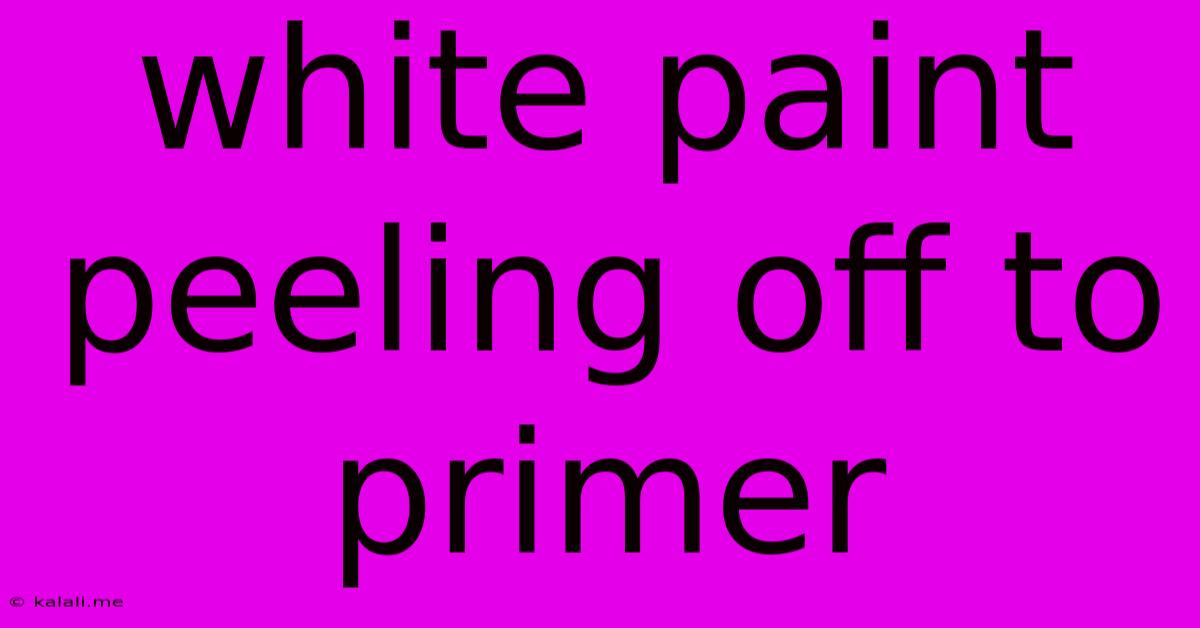White Paint Peeling Off To Primer
Kalali
May 28, 2025 · 4 min read

Table of Contents
White Paint Peeling Off to Primer: Causes and Solutions
Meta Description: Frustrated with peeling white paint revealing the primer underneath? This article dives into the common causes of this frustrating paint problem, offering practical solutions to restore your surfaces to a flawless finish. Learn how to prevent future peeling and achieve a long-lasting, beautiful paint job.
Peeling paint is a common homeowner's headache, especially when that pristine white paint reveals an unsightly layer of primer beneath. It’s not just an aesthetic issue; it compromises the protective barrier of your walls and surfaces, leaving them vulnerable to moisture damage. But don't despair! Understanding the root cause is the first step to fixing the problem and preventing it from recurring. This article will explore the reasons behind peeling white paint and provide effective solutions for a lasting, beautiful finish.
Common Causes of Peeling White Paint
Several factors can contribute to white paint peeling back to the primer. Identifying the culprit is crucial for selecting the right repair strategy. Here are some of the most common culprits:
-
Poor Surface Preparation: This is often the primary culprit. Insufficient cleaning, failure to remove loose paint or existing peeling, and skipping the crucial sanding steps before applying primer and paint create a weak bond, leading to peeling. Primer needs a clean, smooth surface to adhere properly.
-
Incorrect Primer Application: Using the wrong type of primer for your surface or applying it too thinly weakens the bond between the primer and the surface, and between the paint and the primer. Ensure you're using a primer suitable for the material (wood, drywall, metal, etc.) and apply it according to the manufacturer's instructions.
-
Moisture Problems: Water damage from leaks, condensation, or rising damp is a significant cause of paint peeling. Moisture weakens the bond between the paint and the substrate, causing it to blister and peel, often revealing the primer underneath. Addressing the moisture source is paramount before repainting.
-
Inadequate Paint Application: Applying paint too thickly, or in overly humid conditions, can trap moisture and prevent the paint from drying properly, causing peeling and blistering. Multiple thin coats are better than one thick coat.
-
Old, Failing Paint: Over time, paint degrades and loses its adhesion. If the underlying paint is already failing, new coats will likely peel. Proper scraping and preparation is essential in these situations.
-
Incompatible Paint and Primer: Using paint and primer from different manufacturers or with incompatible chemical compositions can also lead to poor adhesion and peeling. Always ensure compatibility.
-
Extreme Temperature Fluctuations: Significant temperature changes can cause expansion and contraction of the paint, weakening the bond and leading to peeling, especially in exterior applications.
Solutions for Peeling White Paint
Once you've identified the cause, you can tackle the peeling paint effectively:
-
Thorough Surface Preparation: This is always the first step. Remove all loose paint using a scraper and wire brush. Wash the surface thoroughly to remove dirt, grease, and mildew. Sand the surface to create a smooth, even base for better adhesion.
-
Address Moisture Problems: If moisture is the cause, you must address the source of the leak or dampness before attempting any repairs. This might involve fixing plumbing leaks, improving ventilation, or addressing foundation issues.
-
Prime Properly: Apply a high-quality primer suitable for your surface and the type of paint you will use. Follow the manufacturer's instructions carefully regarding application and drying time.
-
Apply Paint Correctly: Use multiple thin coats rather than one thick coat. Allow each coat to dry completely before applying the next. Work in favorable weather conditions (avoid extreme heat or humidity).
-
Consider a Bonding Primer: If dealing with previously painted surfaces or areas with poor adhesion, a bonding primer can provide a stronger base for the new paint.
Preventing Future Peeling
Prevention is always better than cure. By following these steps, you can minimize the risk of future paint peeling:
- Proper Surface Preparation: Always meticulously clean and prepare the surface before applying primer and paint.
- Use High-Quality Materials: Invest in quality paints and primers designed for the surface you are painting.
- Follow Manufacturer's Instructions: Pay close attention to the application instructions for both primer and paint.
- Regular Maintenance: Inspect your painted surfaces regularly for any signs of damage or deterioration.
By understanding the causes of peeling white paint and following these solutions and preventative measures, you can ensure a smooth, long-lasting, and beautiful finish that will stay put for years to come.
Latest Posts
Latest Posts
-
1 Day Is Like A Thousand Years
May 29, 2025
-
What Does It Mean When Appeals Court Vacates A Sentence
May 29, 2025
-
Can You Undelete A Wordpress Category
May 29, 2025
-
What Does Full Time Mean In Soccer
May 29, 2025
-
Polar Equation To Cartesian Equation Converter
May 29, 2025
Related Post
Thank you for visiting our website which covers about White Paint Peeling Off To Primer . We hope the information provided has been useful to you. Feel free to contact us if you have any questions or need further assistance. See you next time and don't miss to bookmark.